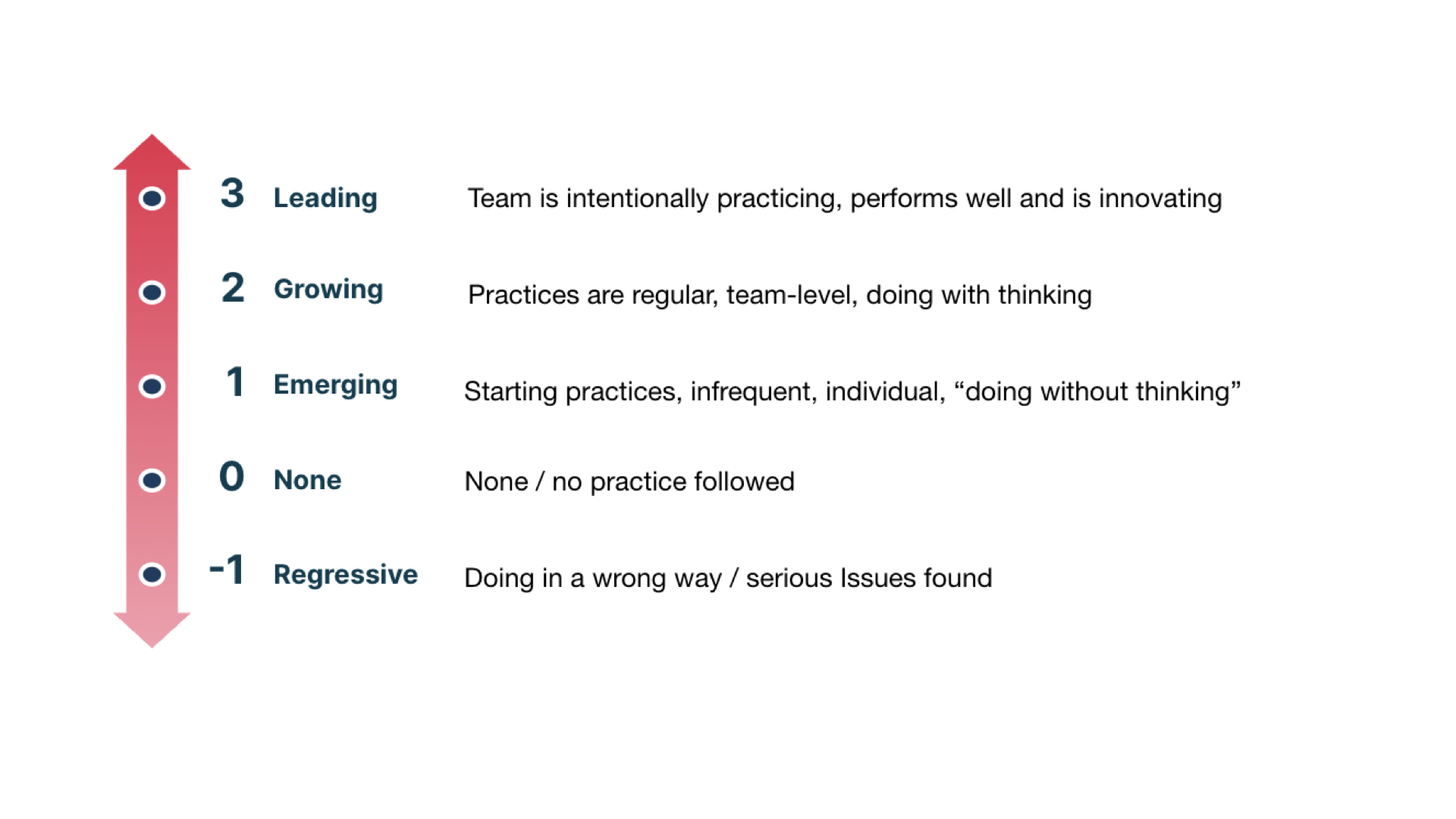Today's software development teams are constantly challenged to deliver high-quality products in the face of ever-changing user needs. Success is by no means a given. So how can teams consistently achieve excellence and deliver exceptional products? Here we present a framework that’s been road tested with some of our most discerning clients.
Thoughtworks’ Digital Product Management Maturity Model (DPM3), also known as the Product Maturity Assessment, targets the team level. It evaluates six independent dimensions and 36 practices that enable your teams to behave as a mature digital product team allowing you to start with dimension(s) and practice(s) that will make the biggest impact. We will provide a detailed explanation of the DPM3 framework and to share a real-world execution involving a client where we implemented the assessment across multiple teams.
DPMMM structure
Six dimensions, six practices per dimension:
| User-centered | Value-driven | Rapid response | Continuous growth | Comms & collab | Steering & governance |
| User segmentation & empathy | Product vision, clarity & alignment | Rolling wave planning | Acquisition strategy | Team product ownership | Transparency & visibility |
| User experience modeling | Vision & goals alignment | Thin slices | Engagement strategy | Timely key ceremonies | Experimental culture |
| User co-creation | Measures of success | Lightweight requirements | Live experiments | Proactive communication | Team autonomy |
| Continuous qualitative research | Holistic view value analysis | Product backlog & grooming | Feedback channels | Effective meetings | Rolling budget |
| Continuous quantitative research | Value validation | Frequent release | Product metrics tracking | Cross-team collaboration | Cross-functional team |
| Continuous trends research | Continuous prioritization based on values | Cycle time & lead time metrics | Product metric analysis & actions | Knowledge base & sharing | Continuous improvement |
Unlock product maturity excellence with Thoughtworks' DPM3 assessment
Before starting, let us introduce Emily, the Client Head of Product. This client trusted Thoughtworks to build scalable products and coach their engineering teams for the last five years. Since this company had a split between engineering and product organizations, their engineering teams were starting to encounter limits on their impact due to constraints in how these teams interacted with the product organization. The leadership team acknowledged they needed a more mature approach to product development but they kept postponing the product transformation because they wanted their engineering teams to focus on an important decommission project, where the goal was to replace legacy systems with smarter and more flexible systems.
When the decommissioned project was about to end, the leadership started to think about new challenges. As Emily explains: "We are so used to working in a project mode where there's no room for innovation and the engineering teams just need to deliver what was defined. We need to change this, we want to be a value-driven organization, allocate time for planning and conducting experiments."
We met with Emily to support her in this new phase for her five teams and introduced our model to assess digital product maturity. The DPM³ was one of the tools that were used to support this product transformation.
One of the first questions that Emily asked was: What are the benefits of running the DPM³ assessment? Our answer was quite straightforward: This assessment can provide a number of benefits to your team, including:
A clear understanding of the team's current product maturity level.
Identification of the team's strengths and areas for improvement.
Recommendations for how the team can improve its product maturity.
A baseline for tracking the team's progress over time.
Readiness to deliver great customer-oriented products.
The second question from Emily was: What are my teams going to be assessed on with DPM³? We explained to her: DPM³ is an honest team reflection exercise from a product-maturity perspective that helps to improve the following six product dimension:
User-centered
Value-driven
Rapid response
Continuous growth
Steering and governance
Comms and collaboration
At this point, Emily was starting to get excited about it but had more questions.
One interesting question was: How can we run this assessment?
We explained to her: this assessment is run as a collaborative process where all team members of a digital product team share their thoughts and assess the 6 product dimensions. In practice, each participant will assess 6 practices for each product dimension from -1 (Regressive: doing in a wrong way) to 3 (Leading: team is intentionally practicing, performs well and is innovating). To help the team with self-evaluation and self-reflection, each practice comes with objective definitions of what it means to be in each of the levels. In order to make sure that we are increasing the product maturity, we recommend you to run this assessment every six months. This iterative process will help you to reflect on the achievements and the impact of the actions taken.


Another question was: How can we identify that we need to run a DPM³ assessment for our team/s? For this question, we explained that we recommend them to consider the following conditions:
Your team is ready/willing to change from project to product mode (please refer here more details about project vs product mode)
Your team is trying to transition from a dominant project operating model to a product operating model, but they don’t have a ‘why’ nor a "how" for this change.
Your team is complaining about their product development speed or responsiveness
Your team is trying to become more customer centric or outcome led
Your team is talking about personal higher growth
Team A journey: navigating the path to digital product maturity with DPM³
Following an introductory session explaining the framework and its expected benefits, we solicited the team's reflections on the future to gauge their aspirations for product maturity. We explained to them that Thoughtworks offers defined patterns for the future state depending on the nature of the product and team topology. However, Team A discussed the future state (long term goal) and opted for a customized approach (not using reference patterns), tailoring it to align with their unique needs and aspirations.
A week later, Team A started the assessment phase. This phase contains six sessions: one for each product dimension. For the first session, we recommended Amy (Product owner), Barbara (Scrum Master) and Mark (Tech Lead) to start with an “easy” dimension (Steering and Governance) because it allowed Team A to familiarize themselves with the assessment process and build confidence. This initial foray provided a solid foundation for the subsequent, more complex dimensions.
During the first session, we asked the team to assess the current state and target/future state (where they want to be in the future) for all practices related to Steering and Governance (e.g experimental culture, team autonomy…) Throughout the assessment sessions, Team A cultivated an environment where every voice was heard and valued.
As the assessment progressed, Team A's understanding of their digital product maturity deepened. They expressed satisfaction with the process, recognizing its manageable time commitment and the valuable insights it provided.
Upon completing the assessment with the evaluation of the six dimensions, Team A analyzed the results, identifying key gaps between their current state and their envisioned future state. With a clear understanding of their dimensions priorities, they focused their efforts on enhancing Continuous Growth and User Centered dimensions. To translate their priorities into tangible improvements, Team A prioritized two practices which they want to improve from each dimension and set specific goals with concrete actions for a six-month timeframe. Following the establishment of the six month goals, regular checkpoints were established to monitor progress and ensure that goals were met within the six-month timeframe. Moreover, these checkpoints facilitated ongoing evaluations to determine whether the implemented actions remained effective or required adjustments.
What we've learned while running DPM³ Assessments with the client
Despite successfully implementing the framework with all the teams, we encountered different challenges along the way. Here are some specific tips for anyone interested in successfully running the DPM³ framework with their teams:
Adapt the assessment and be flexible and willing to make changes. The DPM³ framework is a flexible framework that can be adapted to meet the needs of different teams. Don't be afraid to make changes to the assessment practices or definitions, if it will help to create a more engaged and productive experience for your team.
Involve the entire team from the beginning. This is a collaborative framework for team improvement, so everyone should have a say in the process.
Complete the assessments in a timely manner. The assessments can be long, but it's important to finish them within a month for the first round to avoid people disengaging. Follow up assessments could be completed in less time.
Use collaborative tools to facilitate discussion and engagement. Tools like Miro and Mural can help to create a more interactive and engaging assessment experience.
Request feedback after each session. This will help you improve the following sessions and for future teams as well.
Plan different follow-ups for the actions discussed and assign owners to them. This will help ensure that progress is made on the team's improvement plan.
By following these tips, you can use the DPM³ framework efficiently to help your team identify areas for improvement and develop a plan to address them. Using an objective framework helps to clarify the organization’s expectations of what good looks like and ensure that teams get the right support they need to succeed.
Disclaimer: The statements and opinions expressed in this article are those of the author(s) and do not necessarily reflect the positions of Thoughtworks.


















